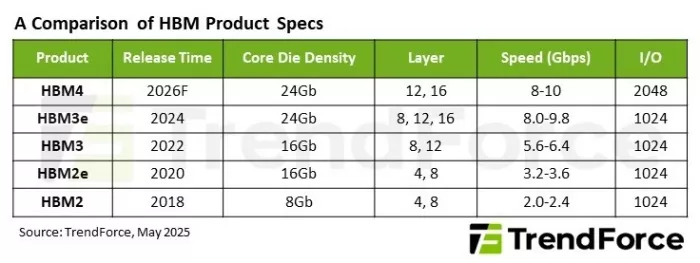HBM4 Raises the Bar on Manufacturing Complexity, Premium Expected to Exceed 30%, Says TrendForce
May 22, 2025 -- TrendForce's latest findings reveal that demand for AI servers continues to accelerate the development of HBM technologies, with the three major suppliers actively advancing their HBM4 product roadmaps.
HBM4 introduces a more complex chip design that expands die size due to a significant increase in I/O count. Additionally, some vendors are also transitioning to a logic-based base die architecture to enhance performance, with both factors contributing to higher production costs. For reference, HBM3e debuted with an estimated 20% price premium; HBM4’s elevated manufacturing difficulty is expected to drive premiums above 30%.
Leading AI chipmaker NVIDIA unveiled its next-generation Rubin GPU at this year’s GTC, while AMD is preparing its MI400 series as a direct competitor. Both are expected to feature HBM4.
TrendForce notes that HBM4 doubles the I/O count from 1,024 to 2,048 compared to previous generations, while maintaining a data transfer rate above 8.0 Gbps—on par with HBM3e. This implies that HBM4 can deliver twice the data throughput at the same speed, thanks to its increased channel count.
Moreover, current HBM3e base dies utilize a memory-only architecture that acts as simple signal pass-throughs. In contrast, SK hynix and Samsung are collaborating with foundries to adopt a logic-based base die design for HBM4. This new approach enables closer integration between HBM and SoC, offering lower latency, improved data path efficiency, and greater stability in high-speed transmission environments.
Amid robust demand, TrendForce forecasts total HBM shipments to surpass 30 billion gigabits in 2026. HBM4’s market share is expected to grow steadily as suppliers ramp up production, ultimately overtaking HBM3e as the mainstream solution by the second half of 2026. SK hynix is projected to retain its leadership with over 50% market share, while Samsung and Micron will need to further improve yields and capacity to narrow the gap in the HBM4 race.

For more information on reports and market data from TrendForce’s Department of Semiconductor Research, please click here, or email the Sales Department at SR_MI@trendforce.com
Related Semiconductor IP
- HBM4 PHY IP
- HBM4 Controller IP
- TSMC CLN3FFP HBM4 PHY
- HBM4 Memory Controller
- HBM4E PHY and controller
Related News
- VSIA readies Web tool, system-level design specs
- VSIA readies four SoC design specs
- RosettaNet, ECIX may collaborate on e-transaction specs
- VSIA bids to jump-start system-on-chip specs
Latest News
- Rivian Unveils Custom Silicon, Next-Gen Autonomy Platform, and Deep AI Integration
- NanoXplore raises €20 million from MBDA and Bpifrance to accelerate its diversification into defense and its growth in support of European strategic sovereignty
- Omni Design Technologies Appoints Hinesh Shah as Vice President of Strategic Sales
- DHRUV64: India’s First 1.0 GHz, 64-bit dual-core Microprocessor
- QuickLogic Announces Expanded Scope of Strategic Radiation Hardened FPGA Contract